Shipyard named after 61 communard. Battleship "Rostislav"
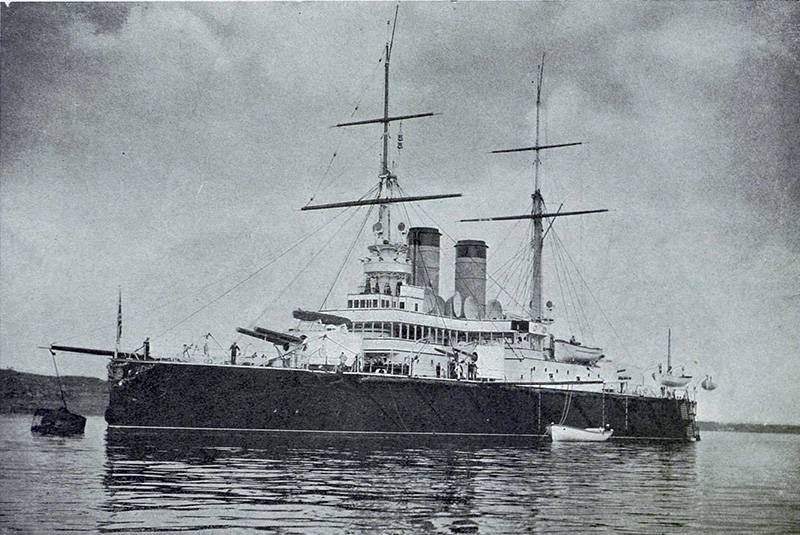
It was significantly different from its predecessors and, being the seventh Black Sea armadillo, was already the fourth constructive type. The previous ones are the ships of the Catherine II type and the non-serial Twelve Apostles and the Three Saints. Rostislav was an attempt to re-create a compact ship for operations in the coastal areas of the Black Sea. Its prototype was the Baltic battleship Sisoy the Great.
Prototype "Sisoy the Great"
A characteristic feature of domestic shipbuilding at the turn of the century was that the decisive voice in determining the appearance of the future ship belonged not to analysts from the Main Naval Staff or the Marine Technical Committee, but to the manager of the Naval Ministry or Admiral General.
In the autumn of 1890, the Marine Technical Committee turned to the head of the marine department for instructions on which battleship should be laid at the shipyard of the New Admiralty in St. Petersburg after the Gangut being built there. It was assumed that the fifth Baltic battleship created by the 1882 program of the year was supposed to be an improved Gangut with three 305-mm guns, four 152-mm and the same number of 120-mm guns. The ship's displacement was determined in 8500 tons, and the maximum speed in 16 nodes.
The preliminary project “Ganguta No. XXUMX”, as it was called before the name was assigned, was already prepared in the Marine Technical Committee, and now Admiral Chikhachev, the manager of the Naval Ministry, had to take the floor. The future battleship caused mixed reactions and different opinions in the naval environment.
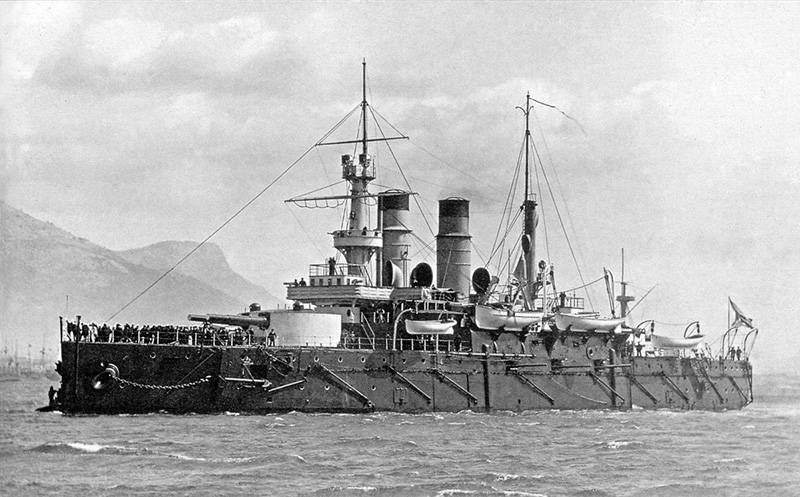
So, for example, Vice-Admiral Nikolai Vasilyevich Kopytov in an extensive memorandum convincingly argued that the construction of battleships was a waste of resources and time. In his opinion, it was necessary to concentrate efforts on the commissioning of a large number of cruisers, of which the fleet should consist. Vice-Admiral Alexey Alekseevich Peshchurov, referring to the experience of building the Black Sea battleships, considered the 16-nodal speed unattainable for the future ship.
Rear Admiral Stepan Osipovich Makarov, who was in the position of Chief Inspector of Naval Artillery, expressed his authoritative opinion. Makarov drew attention to the traditional overload in the construction of ships. He determined the power of the machines as insufficient for obtaining the required speed and assumed that the battleship would also be “heavier” than the design data of nine hundred thousand. Makarov immediately proposed to increase the displacement by at least 500 tons, in order to avoid overloads, if possible. 152-mm guns, as obsolete, in the opinion of the rear admiral, should have been replaced with the Armstrong's 120-mm guns. Although Admiral Chikhachev put forward the resolution “Deserves full attention” on Makarov’s note, the main proposals set out in it were rejected.
After small changes, the displacement was brought to 8830 tons, the draft of the new battleship was approved by Admiral Chikhachev without comment and transferred for further work to the General Directorate of Shipbuilding and Supplies.
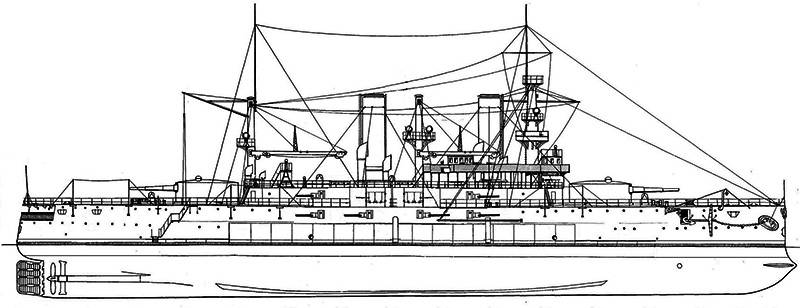
Routine preparation for construction began, constantly beating off the rhythm and target dates by delays in the approval of the drawings. The works in the boathouse started on 20 on June 1891 of the year, and on 21 of December of the same year, the new battleship was named Sisoy the Great. Construction was difficult and was constantly underway.
Despite the "unimpeded" approval of Admiral Chikhachev, the project immediately began to make changes. The initial barbet installations were replaced by closed towers, 35-caliber 305-mm guns - 40-caliber, and their number was increased from three to four. The Armstrong system’s Makarov idea with rapid-fire cannons was rejected, but still the outdated 152-mm guns were replaced with the latest Cané systems. The ordeals of underwater mine vehicles continued for a long time, which the Marine Technical Committee eventually refused. As a result, the battleship was constructively closer to the considered successful “Navarin” than to the dubious “economical” “Gangut”.
The chief commander of the St. Petersburg port, Rear Admiral Vladimir Pavlovich Verkhovsky refused to allocate funds to ensure minimum wages for shipyard workers, which resulted in the outflow of qualified specialists to other plants. Such stinginess in the most decisive way affected the quality of the construction of the Sisoy Great.
The General Directorate of Shipbuilding and Supplies also showed an enviable desire for "savings": all efforts were used to find the cheapest counterparties and suppliers. Thanks to these measures, the supply of equipment, machinery and materials was constantly delayed and disrupted. Foreign firms, in the opinion of naval officials, took expensive, therefore, greatly losing time, the General Directorate of Shipbuilding and Supplies was forced to turn to domestic manufacturers. The latter often lacked the power, experience and qualifications.
20 June 1894 of the Year The Sisoy the Great was finally launched. Outfitting work continued for almost two years, and the battleship was released for testing only in the fall of 1896. As expected in advance, the ship did not reach the estimated speed in 16 nodes, managing to develop only 15,6. Numerous changes to the project, rework and redevelopment increased the overload to 1500 tons. The actual displacement from the original 8800 reached 10400 tons.
Suffering from a number of deficiencies, Sisoy the Great was nevertheless rushed to send for service in the Mediterranean. Outreach work continued on the battleship that left Libau to Piraeus. The command of all the forces tried to bring the ship to a relatively combat state. For the rush and mistakes had to soon pay dearly.
On the way to the Greek port of Piraeus during the shooting of the main 3 caliber in March, 1897, a tragedy occurred. There was a failure of the hydraulic line closing the gun. When attempting to switch to manual, a shot was made with the shutter virtually unclosed. An explosion occurred in the tower - it was torn off with a lid and thrown onto the tank deck. The 22 man died, and Sisoy the Great was forced to leave for the Forge E Shantier shipyard in Toulon.
The French had to virtually completely restore the entire installation. The shipyard specialists and the commission arrived at the scene under the leadership of Alexei Mikhailovich Abaza, captain of the 1 rank, commander of the Svetlana cruiser under construction in France, there was something to be surprised at. In a report, Chikhachev Abaza was forced to pay attention to the glaring quality of the construction of the Sisoi the Great. The spardek’s rivets riveted out, the decking boards sagged under their feet, for they were rotten. Holes in the bulkheads of bomb cellars were not riveted. The top of the trouble was the gap in 31 – 38 mm, which went along the upper edge of the side armor along the entire board - to divert the eyes at the factory, this gap was simply stained.
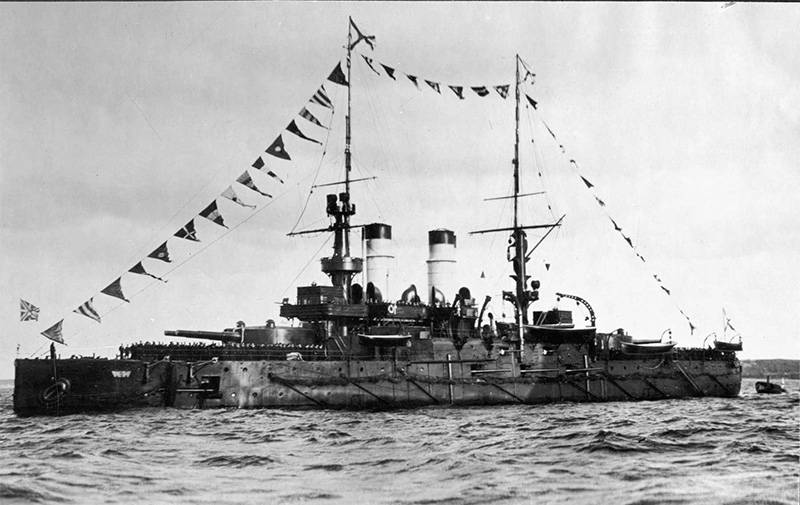
Having joined the 2 Pacific Squadron, Sisoy the Great made the transition to the Far East and took part in the Tsushima battle. The technical condition of the ship played a role in its fate. On the night of 14 on 15 in May 1905, the battleship was hit by a mine from a Japanese destroyer. Unrepaired and rusty transverse bulkheads could not withstand the pressure of the water, and on the morning of May 15 “Sisoy the Great” met with a strong heel. At Tsushima Island, the battleship was surrounded by a detachment of Japanese ships, and, being in an unfit state, surrendered. The winners took the team, but could not take advantage of the trophy - the squadron battleship “Sisoy the Great” soon sank from damage received and did not replenish the Japanese imperial fleet, unlike the ships from Rear Admiral Nebogatov.
Rostislav. Project Storms
The construction of Sisoi Veliky in the Baltic was reflected in the plans to create new battleships for the Black Sea. Once again, the Naval Ministry began to harbor the old idea of creating a relatively small ship that would have powerful weapons, good seaworthiness and at the same time had a small draft, allowing it to operate in coastal areas.
In 1892, the then Commander-in-Chief of the Black Sea Fleet, Vice Admiral Nikolai Vasilievich Kopytov, was instructed by the Naval Ministry manager Admiral Chikhachev to draft a low-tonnage battleship. “Having chosen for this purpose foreign samples,” it was necessary to design and build several small ships within the 4 – 5 thousand tonnes of displacement.
The chief ship engineer of the Nikolaev port, Savery Ksaveryevich, the Warrior, soon presented the 4 variant of the future battleship project with a displacement ranging from 4700 to 6000 tons. Vice Admiral Kopytov found the most acceptable option with two 305-mm guns in the barbet unit and six X-NUMX-mm guns. This option was demonstrated on the report of Admiral Chikhachev in July 152.
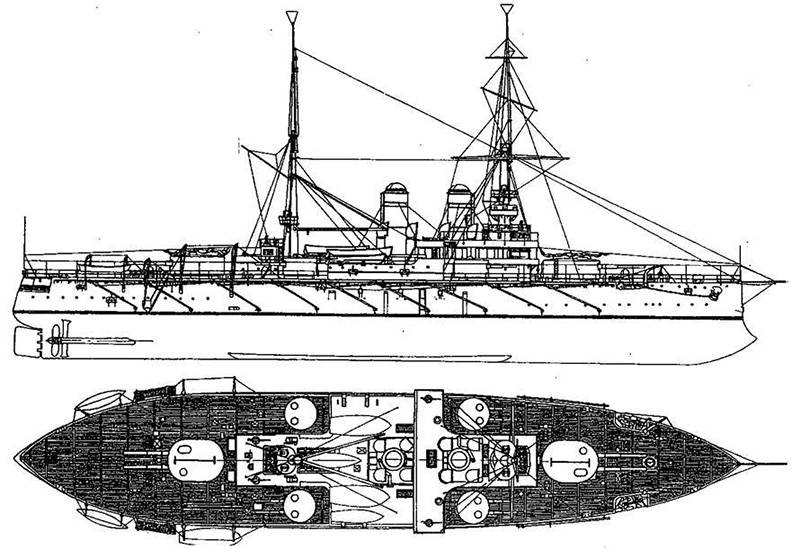
However, the next meeting of the Marine Technical Committee on the next Black Sea battleship was held only in January 1893. It was a striking conclusion that, while maintaining the displacement in 6 thousand tons, there is no room for modernization. From the impasse that was formed, the exit was indicated by the same naval engineer, the Warrior, who had been transferred to the Baltic Shipyard by that time. He proposed to save time and resources for the Black Sea to build a battleship modeled on the “Sisoy Great” with some changes. The Maritime Technical Committee decided to evade a direct answer and wait for the decision of the manager of the Maritime Ministry.
In April 1893 of the year, an expanded meeting of the Marine Technical Committee was gathered with the participation of junior flagships, admirals and commanders of 1-rank ships that were or were being built at that time in St. Petersburg. In the course of it, a rather energetic discussion flared up about the advantages of new 254-mm guns over traditional 305-mm, and the argument was given without any serious analysis.
Proponents of innovation relied on a lighter tower design and greater rate of fire. At such trivialities like decreased armor penetration and firing range in the heat of a dispute, they somehow did not pay attention. As a result, 254 mm as the main caliber were considered promising.
Admiral Chikhachev was still hesitant. The head of the Marine Ministry, finally moving away from being tied to the “low-tonnage” battleship, ordered the new chief engineer of the Nikolaev port, A. P. Toropov, to develop the ship’s project, based on Sisoy Veliky, replacing the gun in the casemates with towers.
Toropov soon presented his vision of the new ship. He had a displacement of 7500 tons, the main caliber of four 254-mm guns located in the end towers. An auxiliary caliber of eight 152 mm was also located in two-gun turrets, two on each side. Maximum armor thickness reached 356 mm.
Among the interesting technical solutions in the Toropov project, the presence of the latest Belleville water-tube boilers should be noted, which rather significantly increased the power of the machines. In addition, they allowed the use of liquid fuel - fuel oil. The accompanying documentation indicated that it was possible to install 305-mm guns, however, with completely filled coal holes, the main belt of the battleship would go under water on the 0,25 m.
Departmental hurricanes and paper speeds began spinning around the main artillery of the future battleship. Many prominent naval figures, including Stepan Osipovich Makarov, resolutely expressed themselves against 254 mm. The last point in the dispute put the General-Admiral Grand Duke Alexey Alexandrovich, recognizing the installation of 254-mm guns useful.
The difficulties of creating a new ship were not limited to artillery problems. In any case, Chikhachev forbade the installation of Belleville boilers on it, replacing them with more conventional fire-tube boilers. However, it was necessary to preserve the possibility of feeding on liquid fuel. By this time, there was already some experience of using fuel oil as fuel — it was used on some commercial steamers that traveled along the Volga and the Caspian Sea. By the way, the Ministry of Finance promised to reduce prices for supplies for the needs of the Black Sea Fleet of Baku fuel oil. The Marine Technical Committee began designing fuel atomization and heating systems specifically for the new battleship.
Construction difficulties
In Nikolaev began preparatory activities for the preparation for construction. Despite the efforts of Vice-Admiral Kopytov, the loading of the stocks immediately after the launch of the Three Hierarchs failed. In fact, work in the boathouse No. 7 began in January 1894, more than three months after the descent of the Three Hierarchs. The head of construction was appointed ship engineer Mikhail Karlovich Yakovlev.
The steel for the corps was supplied by the Bryansk Plant, artillery weapons and part of the mechanisms had to be carried out by the Obukhov Plant. The main mechanisms and ventilation were assigned to the Baltic Shipyard. The same enterprise developed and manufactured a system for feeding four boilers with oil according to the drawings of the Marine Technical Committee. The other four used coal.
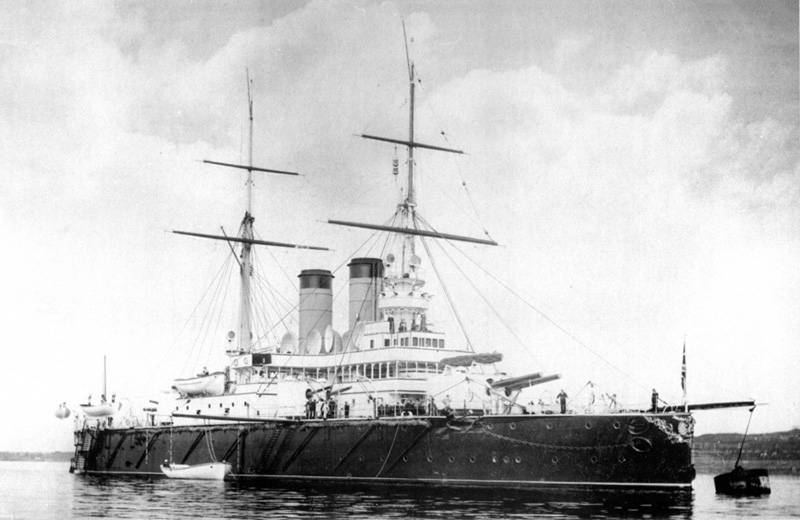
New steel-nickel armor with a total weight of more than 1200 tons ordered from the American company "Bethlehem Iron Company" in the United States. The same company also ordered armor for the battleship "Poltava" and the coastal defense battleship "Admiral Ushakov" being built on the Baltic at the same time. Moreover, the amount of the contract seemed to some congressmen so insignificant that they demanded an investigation.
7 May 1894, the seventh battleship of the Black Sea Fleet was enrolled in the lists with the name Rostislav. 6 May 1895 of the year took place his solemn laying in the Nikolaevsk Admiralty. 20 August 1896, the Rostislav was launched. Already traditionally, construction and completion were slowed down by the disruption of supplies by counterparties and changes made on the go.
In addition, there were local technical difficulties. At the disposal of the Nikolaev Admiralty there was only one floating crane with a lifting capacity of up to 50 tons, and engineer Yakovlev was offered to consider the option of transferring the battleship to Sevastopol for the installation of boilers and machines. But Mikhail Karlovich with honor came out of this situation. By the spring of 1897, he was able to load Rostislav with mechanisms and begin mooring trials. The workers of the Baltic plant completed the installation of an oil heating system for boilers.
At the end of June 1897, Rostislav went to Sevastopol to complete the construction. It lacked armor, weapons and part of the mechanisms. Sea trials were carried out in October 1898. At the measured mile, the battleship showed speed in 15,8 nodes. At the same time, there was a good performance of oil fed boilers. The total mass of mechanisms (1611 tons) significantly exceeded the design weight (1300 tons). The fight against overload turned only a new overload.
Even more troubles were brought by the lauded 254-mm guns, the tests of which at the Obukhovsky proving ground revealed a number of serious flaws, in particular the strength of the barrel. Only in the summer of 1899, the Rostislav received its main caliber, accompanied by a host of instructions and restrictions. The safety charge should be limited to the detriment of the initial velocity of the projectile.
On test shooting in March 1900, one of the 254-mm guns was damaged - Rostislav was forbidden to shoot the main caliber until the fall, until all the flaws were eliminated. However, the problems with artillery were completely resolved only by 1902, and Rostislav could only be fully combat-ready in 1903.
The ship became part of the practical squadron, participated in numerous exercises, shooting, parades and other celebrations. On it the lieutenant swimming qualification later served as the scandalously famous Grand Duke midshipman Kirill Vladimirovich. In winter, 1904 – 1905. from the ship dismantled oil heating boilers, leaving a couple of tanks for storing fuel.
Not spared "Rostislav" and revolutionary events. During the uprising on the Ochakov cruiser, the battleship, despite the fact that the red flag was raised on the mast six times, remained on the side of the government forces and even fired at the rebels.
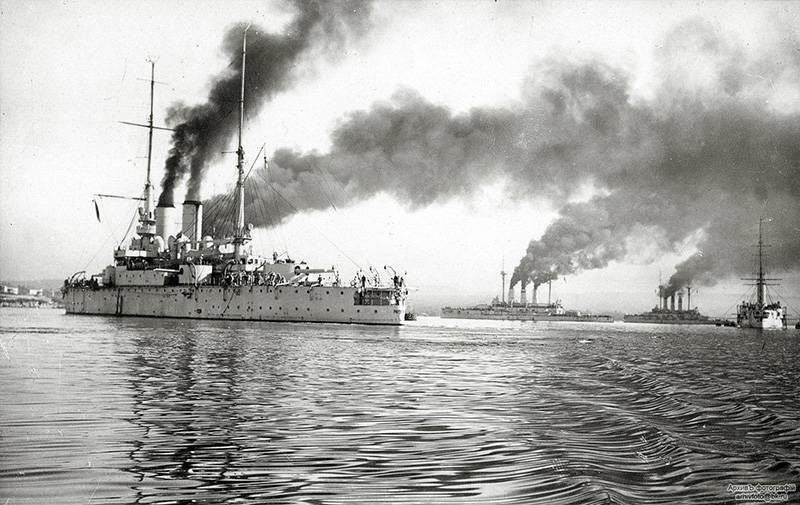
In 1907, the squadron battleship was reclassified into a battleship and was soon upgraded. With Rostislav, absolutely useless mine machines, anti-torpedo nets and other equipment were removed, somewhat reducing the overload. In 1909, the ship sank the Flounder submarine during an exercise with a ram attack, whose crew, except for one person, was killed.
Already largely obsolete, the battleship took an active part in the First World War, in particular in the famous hunt for the German battle cruiser “Goeben”.
The 1917 revolution of the year found Rostislav in Sevastopol. He consistently passed into the hands of the German, and then the Anglo-French authorities. The latter, leaving Sevastopol, knocked out the cars of the old ship, depriving him of the opportunity to move independently.
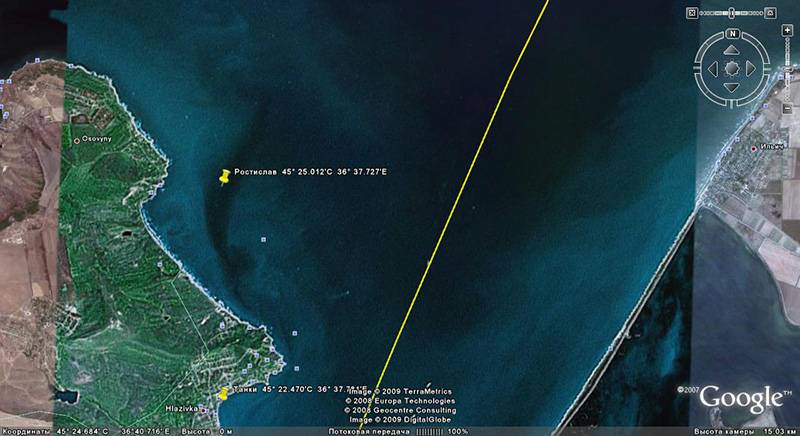
But "Rostislav" was still destined to make war - as a non-self-propelling floating battery, he became part of the naval forces of the white movement and provided for the defense of Kerch. In the autumn of 1920, when the situation for Wrangel’s army became hopeless, Rostislav was flooded in the Kerch Strait to prevent the red flotilla from breaking through the Sea of Azov. But the place of flooding was unsuccessful - the fairway was not blocked, and most of the ship itself rose above the water. The old battleship began to gradually disassemble the metal, but did not do it completely. Part of the hull of the Rostislav, the seventh battleship of the Black Sea Fleet, still rests in the Kerch Strait.
To be continued ...
Information